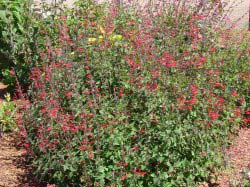Sacred Sage: Pineapple Sage

Many kinds of Sage were considered sacred in ancient times due to their soothing, medicinal qualities. In fact, the plant’s botanical name, Salvia, comes from the Latin word “salvare,” which means to heal and is related to the English word “salvation.”
Pineapple Sage (Salvia elegans), which is native to Mexico and Guatemala, is one such sage. It is a popular folk remedy for relieving anxiety, depression and high blood pressure.
Also one of the most popular culinary sages, it is among the plants grown in the USDA’s National Herb Garden, which focuses on species that “enhance our everyday lives.”
Fresh Pineapple Sage is revered in the modern kitchen for its fruity taste and fragrance. Adventurous cooks add it to baked goods, teas, cheese spreads and jellies. However, Pineapple Sage loses its flavor when dried, so you need to enjoy it during the growing season.
Growing Pineapple Sage
In some USDA zone 9 areas, Pineapple Sage may act as an herbaceous perennial dying back to the ground and growing again in spring. Otherwise, it is a semi-woody subshrub USDA plant hardiness zones 9 to 11 and needs to be trimmed back in early spring to encourage new growth.
In colder areas, such as parts of Missouri and Illinois, gardeners gladly plant pineapple sage as an annual, because of its rapid growth, fragrance and crimson, tubular flowers that bloom from August through October in the Midwest. Some varieties bloom from May to mid-Winter along the Northern California coast.
Sometimes gardeners further north than zones 9 to 11 winter over Pineapple Sage in containers that can be maintained indoors, especially in greenhouses.
Varieties Available at FBTS
At Flowers by the Sea, we grow a variety of Salvia elegans species as well as the hybrid S. x ‘Anthony Parker' -- a cross between Pineapple Sage and Mexican Bush Sage (S. leucantha). All need well-drained soil and — except for S. x ‘Anthony Parker’ — have fragrant foliage and flowers in the red range. They grow well in rich soil and full sun.
Salvia elegans 'Frieda Dixon'. Similar to the pure species S. elegans, this is a tall, late autumn bloomer. It grows up to 5 feet high. Unlike other types of Pineapple Sage, it has salmon-pink blossoms instead of red.
Tangerine Pineapple Sage. In contrast to Frieda Dixon, S. elegans ‘Tangerine’ is a dwarf species that blooms from May through Autumn along the Northern California coast. Unlike many Salvias, it prefers rich soil, regular watering and partial shade. Each plant grows about 18 inches tall and wide during a single growing season. This height, coupled with the plant’s characteristics of dense clumping and spreading by underground runners, make it an excellent groundcover as well as a border sage.
Honey Melon Pineapple Sage. Another possible groundcover, S. elegans ‘Honey Melon’ begins to flower even before Tangerine and continues producing blossoms through Autumn. Similarly short, it grows 24 inches tall and wide in a season. Honey Melon also produces mounded clumps and spreads underground. It prefers full sun in cooler areas and partial shade in warmer zones.
Golden Delicious Pineapple Sage. A striking characteristic of S. elegans ‘Golden Delicious’ is its bright golden foliage. This mid-size variety of Pineapple Sage averages 36 inches tall and wide. It likes rich soil and less water than the other varieties. Similar to Honey Melon, you can choose whether to grow it in full sun or partial shade depending on local temperatures and weather. Also, it does well in containers.
Elk Sonoran Red Pineapple Sage. FBTS selected and developed this compact, dwarf Pineapple Sage variety, which blooms earlier than other types and has larger, deeper red flowers.
Culinary Treats
Looking for Pineapple Sage recipes but can’t find them in your cookbooks? Take a tour of the Internet to find a variety of creative, flavorful uses. Here are a few.
Sonoma County caterer and writer Linda Gilbert recommends the “tangy, citrus-mint flavor” of fresh Pineapple Sage for use in potato-leek soup, salads and Pineapple Sage Pound Cake, a buttery confection including chopped pineapple and lemon zest.
Juliet Blankespoor of the Castanea website demonstrates how to add tasty Pineapple Sage flower petals and other herbal blossoms to a creamy spread made with goat cheese, persimmon, rosemary and honey.
Fresh Pineapple Sage is best with sweet foods that have “soft, gentle flavors,” according to Lynne Rossetto Casper of the Seattle Post-Intelligencer, who buries the leaves in her sugar canister to add a hint of the herb to baked goods and lemonade. She also stuffs it under chicken skin and adds it to a butter sauce that she tosses with new, red potatoes.
Finally, you might want to try this recipe for Pineapple Sage Orange Marmelade from Cooks.com, especially if you pray for marmalade on your biscuits and toast. If you have questions about how we like to cook with S. elegans at Flowers by the Sea Farm, please contact us. We'd love to share tips.

 Salvia x 'Anthony Parker'
Salvia x 'Anthony Parker'  Salvia elegans
Salvia elegans  Salvia elegans 'Golden Delicious'
Salvia elegans 'Golden Delicious'  Salvia elegans 'Honey Melon'
Salvia elegans 'Honey Melon'  Salvia elegans 'Tangerine'
Salvia elegans 'Tangerine'
Comments
There are no comments yet.